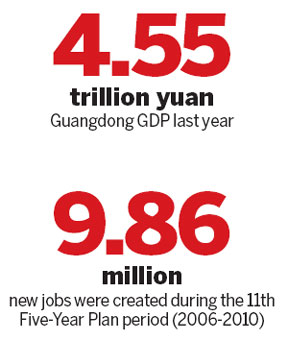Making 'Happy Guangdong'
|
Haixinsha Square in Guangzhou, capital of Guangdong province. Wang Jing / For China Daily |
'Province needs balance between rate and manner of development'
GUANGZHOU - Authorities in this South China economic powerhouse have designed an initiative they call "Happy Guangdong" to improve the quality of residents over the next five years, said Huang Huahua, governor of the province.
"Guangdong will make striking headway in the transformation of its economic development to make improvements in the social strength and livelihood of its people," he said.
"The province needs to keep in balance the relationships between the rate and manner of development, between hard power and soft power, between economic growth and people's livelihoods, between government functions and the market mechanism, and between reform and stability."
He said "soft power includes education, culture and the humanistic environment, while hard power refers to aspects such as economic, scientific and technological strength.

"It is by no means easy at all for the province to balance the relationships," the official said, adding that Guangdong faces severe challenges from global economic turbulence, tightening national economic policies and emerging social problems.
He said that the province will re-map its industrial development to establish multi-layered industrial circles with the Pearl River Delta region as the core and to establish a modern industrial system integrating manufacturing with innovation, and information technology with industrialization.
Priorities include narrowing the income gap between urban and rural residents, creation of jobs, protecting the ecosystem, improving air quality, upgrading public facilities and services, and maintaining social order.
The province expects annual income for both urban and rural residents to grow by 8 percent to 11,500 yuan and 3,500 yuan respectively between 2011 and 2015.
Some 36 percent of high school graduates are expected to have access to the higher education, while a high school education will be available to 90 percent of junior high school students.
The pension system is expected to cover an urban population of 37.7 million and 15 million in rural areas, with medical insurance available to 98 percent of the province's population in the five years.
Guangdong had a GDP of 4.55 trillion yuan in 2010 - outpacing Singapore, Hong Kong and Taiwan - with per capita GDP approaching $7,000, according to official statistics.
The province ranked second for three consecutive years in the nation's comprehensive indices of regional innovation capabilities, with patents and related awards topping any other province, province-level city or region.
Some 9.86 million new jobs were created in Guangdong during the 11th Five-Year Plan period (2006-2010) with the income disparity between urban and rural populations narrowing.
(China Daily 06/01/2011 page60)















